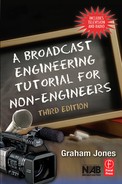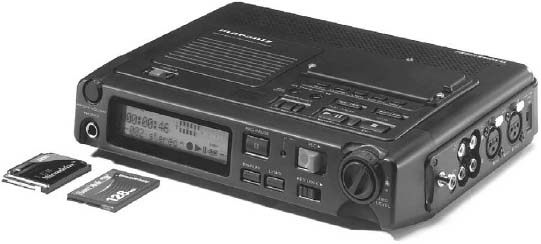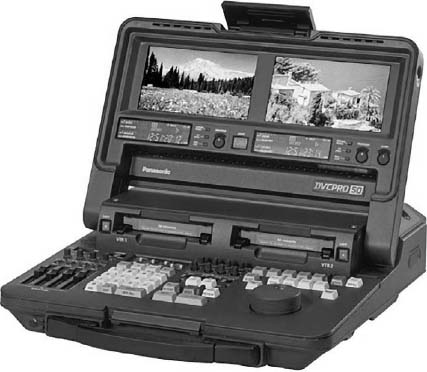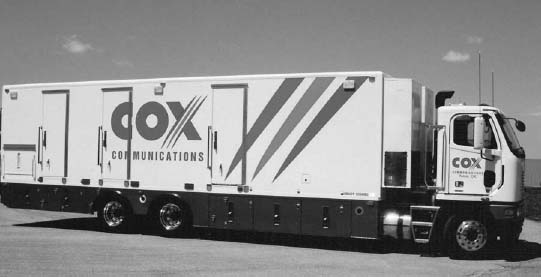Remote Broadcasting
Remote broadcasting covers production, or acquisition of program material, in locations away from the studio center. News is an important part of radio and television broadcasting, and television, in particular, relies greatly on production that takes place outside the studio, for sports, music events, and drama production.
The acquisition systems for news and other remote production activities are described in this chapter, while the link systems for getting them back to the studio are covered in Chapter 11.
Radio News Gathering
Radio news gathering (acquisition) includes reporting from the field, recording interviews, press conferences, and so on, and transporting them back to studio centers for incorporating into news programs. Most equipment for radio news acquisition uses the same principles as fixed radio studio equipment. However, the emphasis is on portability, ruggedness, and ease of use in difficult conditions. Microphones are normally highly directional and may have windshields to reduce the effect of wind noise on the microphone diaphragm. Recorders are often small enough to be held in the hand and may use tape cassette, MiniDisc, or, increasingly, solid-state flash memory, with both microphone and line-level inputs. An example of a solid-state flash memory recorder is shown in Figure 10.1. Recorders may have two or more inputs, or a small external mixer may be used for multiple sources. Monitoring is on headphones, and battery power is essential for all equipment.
Figure 10.1. Portable Compact Flash Recorder Courtesy of Marantz
When covering press conferences, a common audio feed is often provided from the podium microphones, which is split and distributed for use by multiple reporters.
Recorded media may be transported back to the studio for editing, or live contributions may be sent over contribution links of various types, as described in Chapter 11. When on remote assignments, some reporters may take a portable mixer and more than one recorder to allow them to edit a report in the field, before sending it to the station. It is also possible to transfer audio files from a digital recorder to a laptop computer and edit the material there. At the other extreme, the simplest live arrangement is the reporter speaking over a regular telephone line or cell phone.
Cue Audio
Wherever possible, the audio sent to a remote contribution site for cue purposes is a mix-minus feed from the audio mixer (i.e., the output of the studio, minus the contribution audio). This helps avoid problems with audio feedback and makes two-way communication with presenters and talent possible.
The reporter may also have a portable receiver for listening to the station output off-air. This gives the reporter an indication of what is going out, but preferably should not be used for cue purposes.
Radio Remote Production
Radio remote productions include live or recorded programming such as sporting events, concerts, promotional events at county fairs and other shows from outside the studio. Facilities required may range from simple to complex.
Equipment is usually transported in carrying cases in a small truck and may include portable or smaller versions of equipment used in the studio of the following types:
• Microphones, headphones, headsets (combined mic and headphone)
• Audio mixer
• CD players
• DAT, MiniDisc, and Compact Flash recorders
• Monitor loudspeakers
Other equipment that may be needed for some types of remote events includes the following:
• Wireless microphones
• Public address amplifier and speakers
For live broadcasts, some of the same equipment as listed for news reporting may be used for communicating with the studio, and in addition the following may be needed:
• Remote pickup (RPU) radio link system
• Portable antenna system for RPU
Television News Gathering
Electronic news gathering (ENG) forms an important part of broadcast station operations. As with radio, most of the equipment uses essentially the same principles as fixed television studio equipment. However, the emphasis is even more on portability, ruggedness, and ease of use in difficult conditions, compared to equivalent TV studio equipment.
ENG news crews and their equipment may be transported in a small truck or wagon or may work with a larger truck that includes a microwave link or a satellite uplink for live communications with the studio.
Cameras and Recorders
ENG cameras all have built-in recorders, so the term camcorder is often used. Most of the small VTR formats have been used at one time or another. Principal formats used today include BetacamSP, DVCPRO, DVCPRO50, and DV. The new generation XDCAM (optical disk) and P2 (solid-state) recorders are intended primarily for ENG and EFP applications and are likely to be widely adopted. Figure 10.2 shows an example of a portable camera with a built-in P2 solid-state recorder.
Figure 10.2. Portable Camera Courtesy of Panasonic
At the time of writing this book, only a small number of stations are producing news in high definition and equipping their news crews with HD camcorders. That situation may change as the migration to DTV continues and the cost of HD equipment continues to fall.
Cameras are usually handheld (actually shoulder-mounted) but may be used on a tripod, with a pan-and-tilt head, or installed in a vehicle or helicopter, where a gyro-stabilized mount is required to produce stable pictures. The crew may have a portable lighting kit to supplement available light where necessary.
Recorded media may be transported back to the studio for editing. Alternatively, live contributions or recordings may be sent to the studio over contribution links of various types.
Cue Feed
For live contributions, a cue audio and video feed from the studio is required to allow the reporter to speak when required and/or converse with the studio staff. With NTSC transmission, this cue feed is often taken from the station off-air signal, using the Pro subcarrier channel for audio (see the Audio Signal section in Chapter 14). With DTV transmission, it is not possible to use the off-air signal for cue purposes, since there is no equivalent of the Pro channel, and the main program audio has a significant coding/decoding delay. So, when NTSC transmissions come to an end, other arrangements will have to be made. Either ENG links will need to be made bidirectional in order to provide a return path or another return link method will need to be established. In the mean time, communications are usually established with mobile radios and cell phones.
Field Editing
Ultra-compact editing facilities are available and may be taken on assignment to edit and assemble stories while in the field. An example of a portable two-deck DVCPRO format VTR editor is shown in Figure 10.3. Material may also be digitized and transferred to a laptop computer for editing in the field.
Figure 10.3. Portable Editor Courtesy of Panasonic
ENG trucks equipped with microwave or satellite links may also be equipped with basic editing machines or have equipment to allow material to be reviewed before sending to the studio.
Television Remote Production
Remote field production falls into two main categories: (1) electronic field production (EFP) with portable equipment and (2) mobile production relying on equipment installed in mobile vehicles.
Electronic Field Production
EFP normally uses portable self-contained equipment that can be transported in rugged shipping cases. Sometimes, however, EFP equipment may be installed in a small truck or van, so the distinction between EFP and small-scale mobile production is blurred. However, EFP is usually done with single-camera shooting, although it is possible to use multiple cameras when required.
So the main distinctions from ENG are that the equipment and crew may be somewhat larger, usually the program output is recorded on-site for later postproduction, and, wherever possible, studio-quality video and audio is maintained. In addition, sound is usually mixed with a portable mixer before recording on the camera, and mains power may be available, so a wider variety of equipment can sometimes be used.
Cameras
There is some overlap between cameras used for EFP and high-end ENG cameras. EFP cameras usually have superior picture quality and may be high definition. It is also common for EFP to use a camera with a base station and separate recorder. This allows a vision engineer to monitor and control picture quality, using a picture and waveform monitor during shooting.
Where steady shots are required from a handheld camera that has to move, the camera is fixed to a special counterbalanced and stabilized mount that is strapped to the operator, who can then walk or even run without affecting the picture stability.
Recorders
EFP recording tends to be done with higher-quality tape formats, currently such as Digital Betacam or HDCAM, but there are no hard-and-fast rules.
Mobile Production Trucks
Mobile production trucks, also known as remote trucks or outside broadcast (OB) vehicles, have been used for television broadcasting for decades. They provide most of the facilities of a fixed production studio, but in a mobile environment. Figure 10.4 is an exterior view of a large production truck. Inside, the unit is divided into air-conditioned areas for production control, audio control, vision control, recording, and other equipment. Trucks may be powered from a mains power supply at the remote site, but where this is not available, a trailer-mounted and soundproofed electrical generator may be used. Some trucks have their own built-in generator.
Figure 10.4. Remote Production Truck Courtesy of Gerling and Associates
Equipment
Mobile trucks may carry full-size studio cameras or portable cameras, or often both for flexibility in use. Camera mounts are usually tripods. Typically, the cameras will have lenses with very long zoom ranges, to bring action up close, and will have long camera cables, sometimes several hundred meters. Fiber-optic cables are used for distances up to several thousands of meters, or cameras may have radio links, with no cable at all.
Trucks have storage lockers for the portable equipment in the lower skirts of the vehicle. Cables are stored on drums, which may be motorized for ease of handling. Cable connections for cameras, microphones, and other feeds in and out of the truck are made on a special connection panel in a compartment that is shielded from the weather.
Equipment types in the vehicle, including switchers, monitors, VTRs, servers, audio console, communications systems, and so on, are all much the same as those used in studios.
Slow-Motion Cameras
Special cameras are available to help produce high-quality slow-motion pictures, especially for action replays in sports programming. Slow-motion playback requires more frames than are recorded for a normal speed motion. Therefore, when a conventional camera is used, frames have to be repeated upon playback, resulting in jerky motion. A slow-motion camera works at a higher frame rate, and more frames can be recorded on an associated hard disk recorder. This enables much smoother motion when played back at slower speeds. A special controller is used for slow-motion replay, which provides rapid access to particular parts of the action and controls the playback speed and other functions.




